Menu
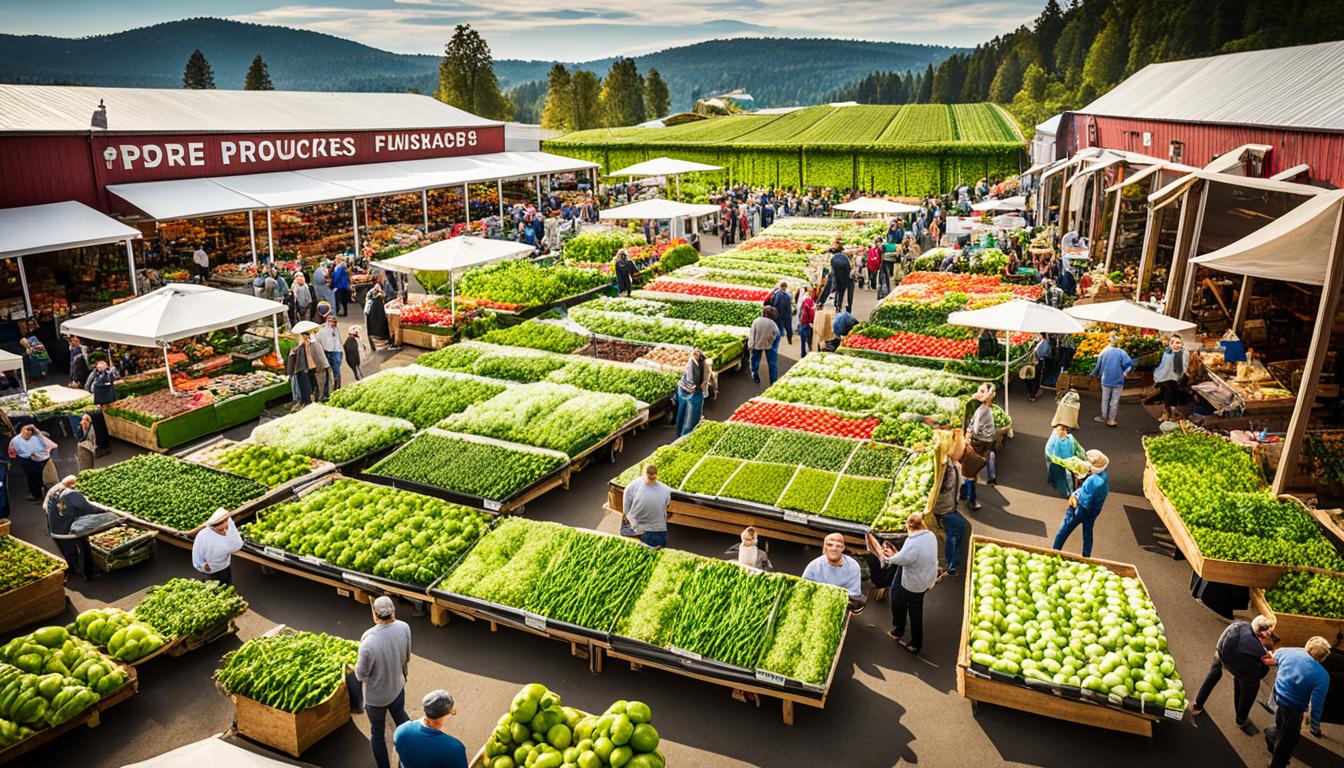
Did you know that businesses using various selling avenues can widen their reach by up to 200%? This lets them find new markets and grow their audience. This shows how powerful it is for farm operations to sell through many channels. It not only increases their earnings but also makes customers more loyal to their brand. Farm owners see the value of connecting directly with consumers. They must, wisely, handle the complex world of multi-channel sales.
Farm sales have many moving parts. Operators market goods through various routes like meats, fruits, and vegetables. It’s key to know the prices for things like handling after harvest, time it takes to move them, and how to advertise. Doing a full check on the market and picking the best marketing points for your goals is crucial. Also, online marketplaces for food, like the Food Farm Hub, are a big part of selling through many channels.
Looking at which market lanes get the most sales and how much they spend on marketing can help. For example, the performance of veggie sellers using CSA and farmers’ markets has shown interesting results. This helps to figure out the best ways to earn more and grow sustainably.
Knowing about multi-channel sales is key for today’s farmers. They include selling online and in physical stores. This method helps farmers reach a wider market, make more money, and build a better brand. Yet, it has its hurdles. Doing it right goes beyond just selling in different ways.
Multi-channel sales means selling farm products in many ways at once. This could be at local stores, online, or on social media. The aim is to offer many buying options to customers. This approach can lead to more sales and visibility for farms.
An omnichannel approach can greatly improve the customer’s shopping experience. For example, from 1997 to 2007, farm sales directly to consumers almost doubled. This shows people are more and more interested in buying straight from farms. Also, farmers’ markets in the US increased by 20 percent, proving a growing demand for farm products.
But, using many sales methods at once comes with its own set of problems. It’s tricky aligning your online and in-store sales. This includes keeping track of what you sell and showing the same brand image everywhere. Plus, using many platforms can cost a lot – for example, marketing costs at farmers’ markets in Tennessee went up by 56 percent between 2006 and 2009.
Still, farmers’ markets are a good start for branching out. They offer great insights, don’t need a big investment, and let farmers talk directly to customers. By learning from face-to-face sales, farmers can improve their online strategies. This makes all their sales methods work smoothly together.
Farmers need to choose wisely between sales options. These include selling in stores, online, or through social media. Each method has its own pros and cons, so deciding carefully is crucial.
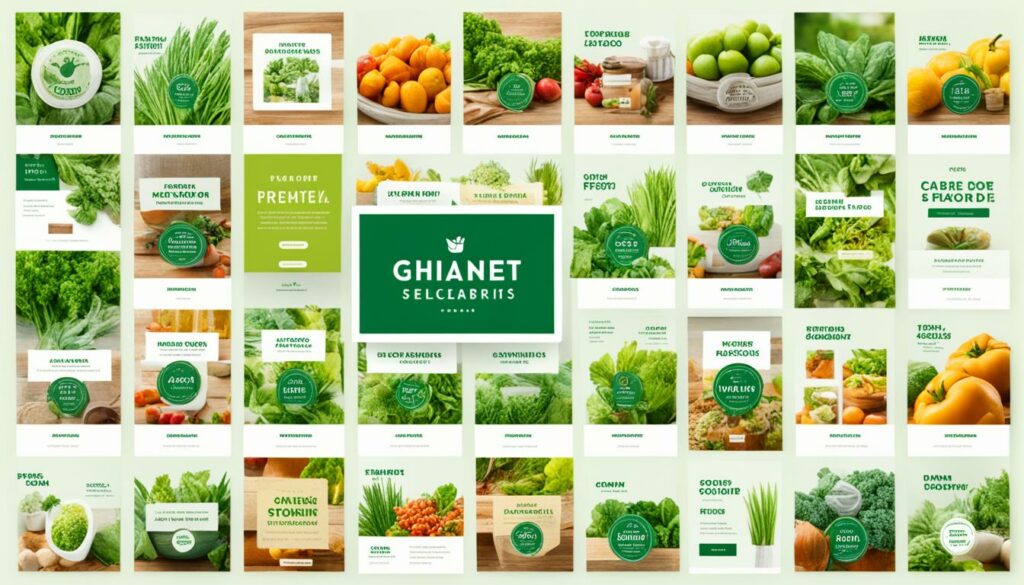
Having physical stores lets customers touch and see products. This can boost sales by letting farmers interact with shoppers. Yet, setting up and running physical premises is costly. Online platforms like Amazon and Food Farm Hub, on the other hand, offer a broader market. But, selling online takes smart planning to handle stock and keep customers happy.
Using social media like Facebook and Instagram helps farms reach more people. It lets them share their produce and connect with customers. Good social media marketing can really boost sales and make a farm stand out.
The ‘Managing multi-channel sales for farm products’ guide recommends using a mix of direct and wholesale sales. This is especially good for selling easily spoiled crops. It helps farmers earn more by selling in multiple ways.
Farmers must choose between selling a lot to middlemen for less or directly for more.
Choosing how to sell involves many factors, like how much to sell and how we want to work. Data can show us how different sales methods might affect what we earn. For example, the price we get for strawberries and how many we sell makes a big difference in our overall earnings. This shows why choosing the right way to sell is so important.
| Channel | Sale Price (per kg) | Volume (kg) | Potential Gross Sales |
|---|---|---|---|
| Direct Marketing | $3.50 | 200 | $700 |
| Wholesale | $2.00 | 500 | $1,000 |
Combining different sales methods helps meet customer needs while fitting into farmers’ lifestyles. For example, direct selling from farms to people rose from $8.4 million in 1997 to $15.3 million in 2007. This shows the power of selling straight to customers.
Over the years, farmers have chosen to sell directly more often. This means they sell right to the customer. It’s seen as a good choice because it doesn’t require big sales amounts and it gives farmers more knowledge about what customers want. But, it comes with its own challenges like higher marketing costs. More farmers markets are opening, showing there are more places to sell. But each sales method needs careful thought for the best result.
For farm operators in direct sales, doing a good marketing mix analysis is key. It helps them see which sales ways make the most money. This is by looking at what it costs to sell and how much they earn.
It’s vital to know what part of marketing costs can be most expensive. These include:
These expenses can really affect the money made in the end. So, managing them well is crucial for success.
To analyse marketing mix, compare sales and costs directly. This clear view shows which sales routes are the best. Tools like the Marketing Channel Assessment Tool (MCAT) are great for this. Here’s how it works:
| Sales Outlet | Gross Sales ($) | Annual Marketing Costs ($) | Daily Costs ($) | Time Selling (hrs) | Mileage Expenses ($) | Travel Time ($) | Fees ($) | Net Revenue ($) | Gross Margin (%) |
|---|---|---|---|---|---|---|---|---|---|
| Farmers Market | 36,000 | 8,000 | 80 | 250 | 500 | 1,200 | 400 | 26,900 | 74.72 |
| CSA | 29,000 | 5,000 | 60 | 180 | 300 | 800 | 200 | 22,700 | 78.28 |
Examining the above data helps me see which sales ways are most profitable. It allows for adjusting prices and setting marketing goals for profit. Good use of multiple ways to sell increases marketing success, making each method help the farm succeed.
It’s vital to manage market channels well to boost profits and reach more customers. Each agricultural sales channel has its benefits and risks. Farm operators should pick channels that work well together to sell across different platforms.
Agricultural sales channels vary in their advantages and challenges. Direct sales at farmers markets let producers engage with customers directly. This can boost brand loyalty. Yet, it involves lots of work for the producer and can be expensive. This includes costs for fees, transport, and packaging.
Conversely, when farmers sell through market intermediaries, their prices might be adjusted. This is because wholesalers often change the buying and selling prices. This affects the revenue that farms make.
The type of farm influences which sales channel is best. Small farms might do better with direct sales, while large farms can reach more customers through supermarkets and wholesalers.
Picking complementary sales channels can boost a farm’s overall profit. For example, unsold products from a farmers market can be sold at a farm stand. This reduces waste. Larger farms can use both direct and intermediary channels to expand their reach.
In places like Bangladesh, better transport and communication help farms sell in new ways. This means more chances to use different sales strategies.
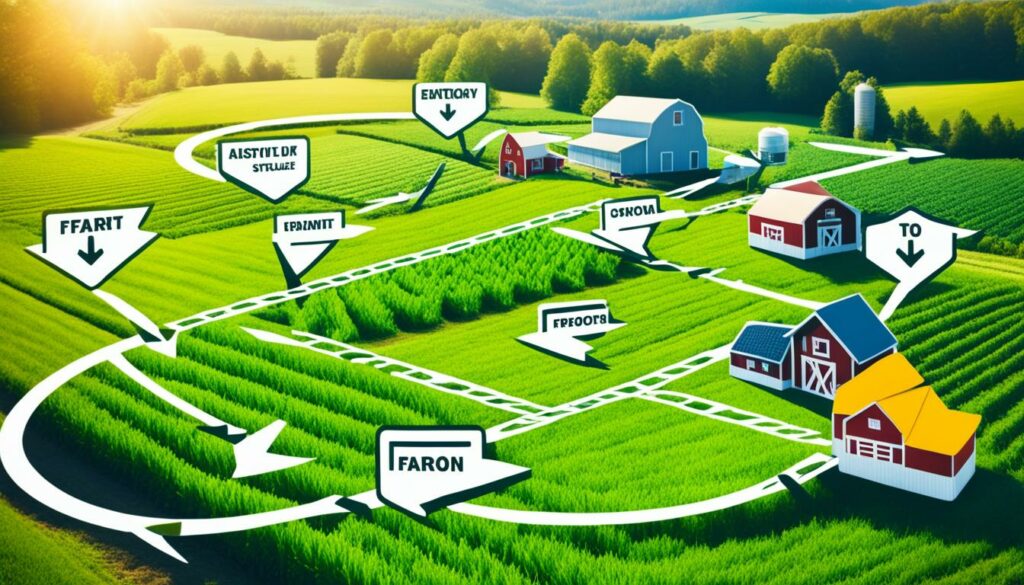
New media marketing can help farms grow a strong customer base. Ways like social media and microblogging are changing how people shop. It’s key to know your consumers well to make the most of your sales channels.
By using a mix of sales channels, farms stay flexible and steady. This approach lets them cater to changing customer needs and market conditions.
The effect of using many sales channels on farms is clearly visible through real stories. By mixing online sales with selling straight to customers, farms have made more money. This also helped keep customers loyal.
When farms sold through different ways, their earnings went up. Adding more sales channels can make revenues grow by large amounts. For some, sales went up by 190% by using several channels. Also, 74% of companies said they sold more, and 57% saw happier customers.
Farms that sell in many ways have seen their sales grow naturally. They don’t need to spend as much on adverts. Today, over half of shoppers check out products in three to five different places before buying. And the average shopper moves between websites and apps about six times before deciding to buy.
Selling in different ways makes products more visible. Think about a farm that’s at markets and online, like Amazon. They don’t just get more attention; they make more money. One farm used social media with other sales and saw 64% more loyal customers.
Here’s a summary of the main gains from using many channels to sell:
| Key Metric | Impact |
|---|---|
| Increased Sales | 74% |
| Improved Customer Experience | 57% |
| Enhanced Consumer Loyalty | 64% |
| Average Customer Engagement with Multiple Channels | 6 switches |
Reaching different types of customers in tailored ways has big advantages. A dairy farm did this with great results. They sold directly, online, and in stores, which brought in more customers and more sales.
In conclusion, having many sales ways, from selling direct to using online sites, changes farm businesses. Using more sales channels not only brings in more money. It also makes customers trust and stick with the farm, boosting their spot in the market.
Integrating internet sales with offline activities can boost profits and keep inventory in check. Today, using online platforms like the Local Food Marketplace (LFM) is key. LFM supports over 12,000 producers, offering tools for detailed inventory management and sales analysis. This brings together a complete sales plan.
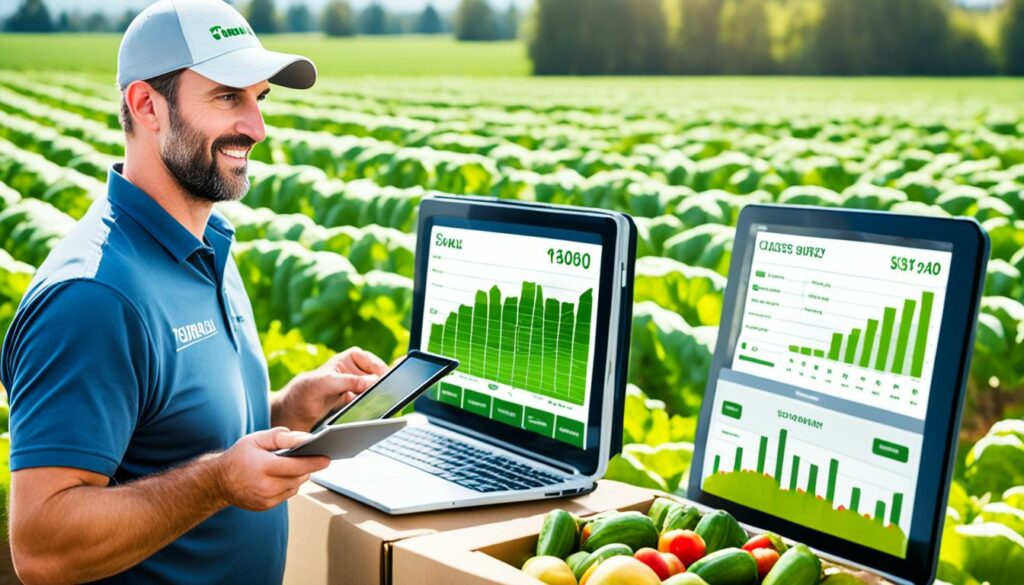
Joining internet and offline sales leads to happier customers and smoother operations. It allows farms to keep track of products in real time across all sales points. Mistakes are cut down and less time is needed for data entry. LFM excels at this, offering reports that cover all sales. These reports help in tracking sales instantly to see what’s selling best and where.
There are many tools that help bring sales together, making the buying experience simpler and marketing stronger. For example, LFM features like Square POS Integration and Mailchimp Integration make managing stock and running marketing campaigns easier. This is especially useful for different sale types like market-style CSAs and analysing what sells best at farmers’ markets.
Using multiple sales methods can really boost sales. Reports show that adding new sales channels increased revenue significantly. More than half of businesses that did this saw better consumer loyalty and customer experience. These stats prove the power of selling in different ways.
In the end, these digital farming tools are all about making smarter decisions based on data. They help tailor approaches to meet different customer needs, which in turn, helps farms grow and stand out in the market.
E-commerce has become a key way for farms to sell their products. It lets farmers use online selling platforms to reach more people. This also helps in selling directly to customers. It means farmers can set their own prices, cutting out the need for middlemen.
In China, Alibaba’s Rural Taobao makes selling farm goods easier. It connects farmers with buyers worldwide. This is vital for reaching more customers and growing a global market.
Advanced tech like IoT devices is changing farming for the better. It boosts efficiency and cuts down on waste. This means farms can be more eco-friendly and strong in online sales.
By selling online, farmers in rural areas can get fair prices without middlemen. This helps reduce poverty and makes it easier to buy fresh, organic food. E-commerce links those who care about the environment with sustainable farms.
The COVID-19 pandemic boosted e-commerce for farm goods, showing its importance. But, it’s slower in some areas like sub-Saharan Africa. High transport costs are a big hurdle there.
E-commerce sites only help a small number of farmers, but they are powerful. Still, not everyone can use them well. Many people don’t have good tech skills. This stops e-commerce from reaching its full potential. Yet, efforts like Women in E-Commerce in Bangladesh are changing lives. They help women use e-commerce better through training and networking.
Even though online selling cuts down on lost crops, it’s not all easy. Farmers might find it tough to sell in traditional ways after. They also have new competition. And, there’s the risk of leaving some people out and losing personal connections with buyers.
Projects like Fruitee-Kenya and KhetiFood in Nepal show that e-commerce can change for the better. These projects went from selling to businesses to selling straight to people. They show the power of online selling platforms to bring hope and new skills to farms.
Social media can help African farmers reach more people worldwide. It allows them to engage with buyers and present their products well. Sites like Facebook, Twitter, and Instagram make communication easy. This makes trust between farmers and buyers stronger.

Social media platforms have different features that help in marketing farm products:
To reach the right people, make content that’s interesting and useful. Photos and videos are key for grabbing attention. It’s also important that your content shows what your farm stands for. Study what your followers like to improve your marketing.
Talk directly with customers online. Use tools like infographics and planning apps to keep your posts interesting and regular. Targeting your posts can make them more effective, helping you sell more.
Online selling platforms are key for selling farm products now. They help farms reach more customers and make more money. But, to do this well, it’s important to understand the benefits and challenges of these platforms.
Farm products do well on online marketplaces. Places like Food Farm Hub, Amazon, and eBay boost product visibility. This can lead to more sales.
Amazon and eBay reach a wide variety of customers. Social media, like TikTok and Instagram, also connects farms with buyers. Over 40% of online sales come from mobile devices. This makes online marketplaces even more important.
To sell well online, farms should use the best methods. Keeping track of stock is vital. Using tools to manage inventory helps avoid problems.
Farms can grow their customer base by talking to people directly on these platforms. They should also use the marketing tools available. And by selling in different ways, they can attract more buyers and make more money.
Selling directly to consumers lets farms make more money by cutting out the middlemen. They’re able to connect with customers direct. This way of selling is becoming more common among small farms. It helps them increase their earnings and create strong bonds with buyers.
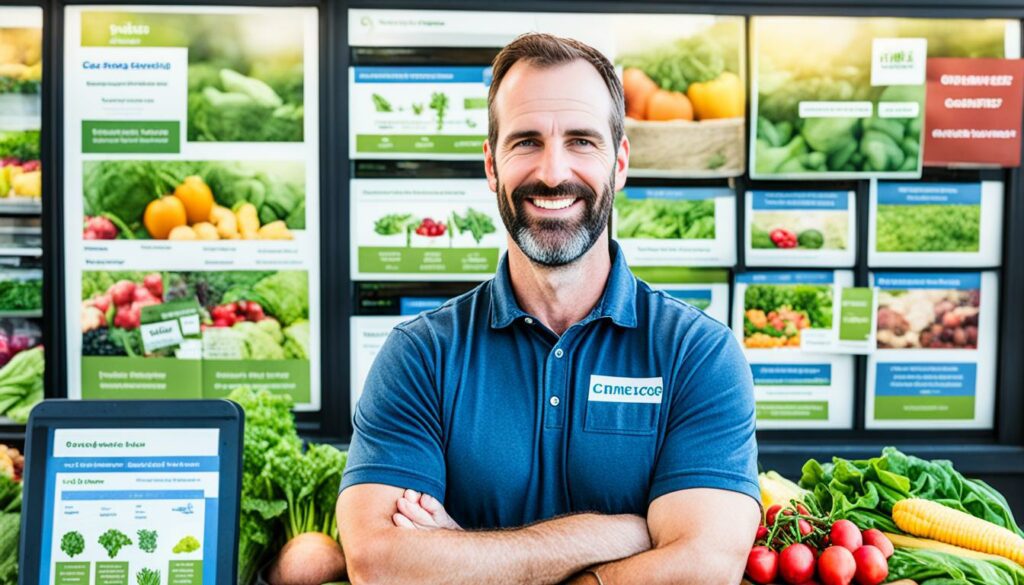
To do well in direct sales, farms have to know what people in their area want. They should also check out what their rivals are doing and choose the best places to sell. It’s vital to follow all the rules and keep customers happy. This improves the quality of what they sell and makes people trust their products more.
Doing market research is key to figuring out what consumers like and what products are popular. The best ways to tell people about your farm’s products are through social media, emails, and your website. Working with local shops and joining big events, like farmers markets, can also help get your products seen more.
Farmers need to keep up with the laws in their area to legally sell their products. Getting organic and food safety certifications makes their products safer and more appealing to buyers.
Because getting into wholesale markets can be hard, many small to mid-size farms sell directly to consumers. Programs like Community Supported Agriculture (CSA) and subscription farms offer them a stable market without huge costs. This not only keeps them a regular flow of customers but also meets the growing demand for quality products, which is why people prefer farmers markets.
Despite the benefits, sales decline by 71.3% when marketing directly to consumers only, compared to a 36.8% decline with diversified marketing decisions. Direct marketing also associates higher sales declines for female farmers.
To reduce risks, having a clear financial plan, managing taxes, and having the right insurance and legal advice is crucial for running a farm business well. Interestingly, bigger farms focusing only on retail tend to earn more than those who don’t directly sell. This shows that mixing different ways of selling can make a farm’s income steadier.
| Marketing Strategy | Mean Sales (USD) | Sales Decline (%) |
|---|---|---|
| Direct-to-Consumer Only | 326,000 | 71.3 |
| Diversified Marketing | 419,000 | 36.8 |
The Farmer-to-Consumer Direct Marketing Act of 1976 encouraged more direct selling from farms. States like California have helped by making it easier. Joining different marketing activities can make a farm more successful and stable. This is good for everyone involved and makes buyers happier.
Top farming sales include great service and personal talks. With good plans, sales at all spots are smooth. This keeps buyers happy and helps the farm stand out.
Great customer care makes buyers happy. By using one system, farms can answer well no matter where they sell. This boosts trust and solves issues fast, making everyone happy.
Many companies see more sales when they sell in lots of ways. Plus, many buyers enjoy shopping this way, making them more loyal.
Getting to know buyers makes marketing stronger. Knowing what buyers like makes their shopping experience better. This makes them keep coming back.
Many people look at a few places before they buy. Making each spot feel special can win them over. This is why splitting up markets helps farms sell more by meeting what everyone wants.
Here is a detailed overview of how multichannel marketing can impact farms:
| Benefit | Impact |
|---|---|
| Increased Revenue | 38% – 190% with each additional channel |
| Increased Sales | 74% of companies experienced increased sales |
| Improved Customer Loyalty | 64% observed increased loyalty/acquisition |
| Enhanced Customer Experience | 57% saw improvements |
| Better Engagement | Customers use three to five channels before purchase |
It’s crucial for farmers to keep an eye on sales data. This helps them make smart choices and improve their business. Tools like Local Food Marketplace provide insights that lead to better decisions.
Analysing data in farming is key for success. It lets farmers make choices that improve their work and make more money. Local Food Marketplace has helped over 12,000 farmers do just that. It merges online and offline sales data, showing the full picture of what customers buy.
Using one platform for all sales can help farmers manage stock better. Knowing what’s selling well in real-time means they can keep popular items in stock. This stops products from running out and cuts down on mistakes in ordering.
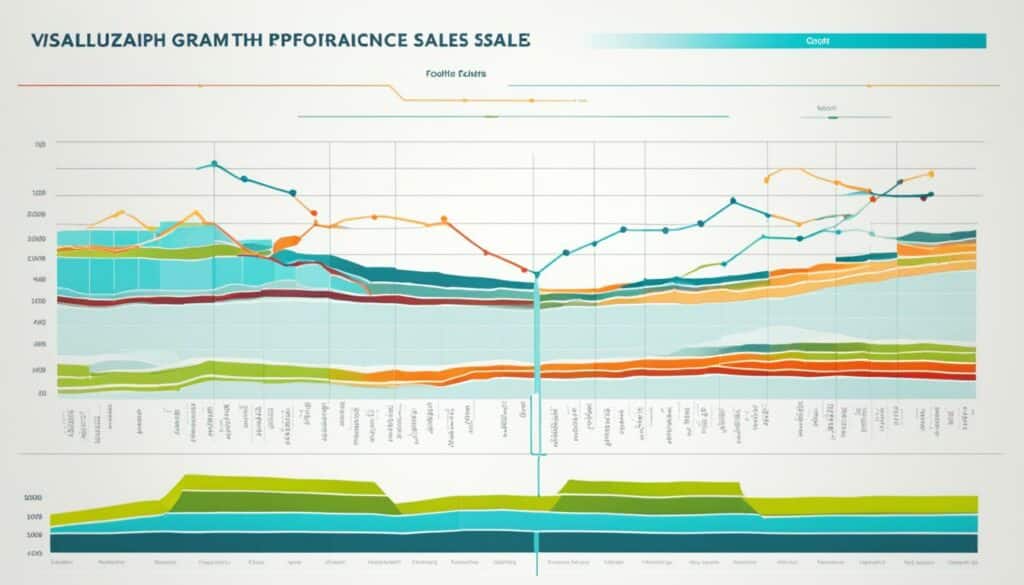
Having the right tools is essential for detailed sales analysis. Local Food Marketplace comes with detailed reports and features like Mailchimp Integration. This makes marketing more effective by sending emails based on what customers most like or need.
Local Line’s advanced tools help with inventory. They can handle different product types and prices with ease. Plus, they send alerts when it’s time to restock. This ensures farmers always have what their customers want.
When farmers use good sales monitoring and analysis tools, their businesses get better. They can adjust their strategies, run things more smoothly, make customers happier, and see more profit. Tools play a big part in their success.
In today’s digital world, individuals see about 5,000 ads every day. This makes using integrated marketing strategies very important for farms. By using these strategies, farms keep their brand consistent, run campaigns together, and keep their messages the same. This helps the farm stay strong in the market and make the most of their investment.
Global advertising spending reached $586 billion in 2020. Big companies like Disney spend a lot on ads to show how vital it is to have the same brand identity everywhere. This not only makes the brand more well-known but also wins trust and interest from people.
Cross-channel marketing brings together customer management tools with online communities and more. It makes information sharing smooth and ensures marketing is in sync. This creates a great experience for customers at every step.
For example, in 2021, NBC charged $6 million for a Super Bowl ad, reaching 96 million viewers. This means it cost about $0.06 to reach one person. It highlights the importance of marketing across many channels. Using such insights, farms can wisely spend their marketing budgets to reach the most people at the least cost.
Bringing marketing together across channels also lets farms change and adapt in real-time. The customer support scene is always changing, so it needs close watching. Combining integrated marketing strategies with analytics helps farms react fast, keeping their campaigns fresh and successful.
Sales tools make selling easier, especially by helping reps find the right content. Adding these tools to a holistic marketing plan makes content easier to find and follow. This boosts how well and often sales happen.
To sum up, a holistic marketing approach that ties everything together is key for any farm’s success. It not just sends a clear brand message, but also uses resources well and draws in customers.
| Channel | Potential Reach | Cost Efficiency |
|---|---|---|
| Online Marketplaces | Broad | Moderate |
| Social Media | Extensive | High |
| Brick-and-Mortar | Local | Variable |
| Direct-to-Consumer | Targeted | Cost-Effective |
Farms need to keep up with new trends in agriculture to stay ahead. By knowing how these trends affect sales, they can be more competitive.
Technology is changing farming. It brings new ways to do things, like using robots and smart machines. This makes farming smoother. Adding maths and science to farming lets farms sell things in better ways. They can offer what people want because they know what they like.
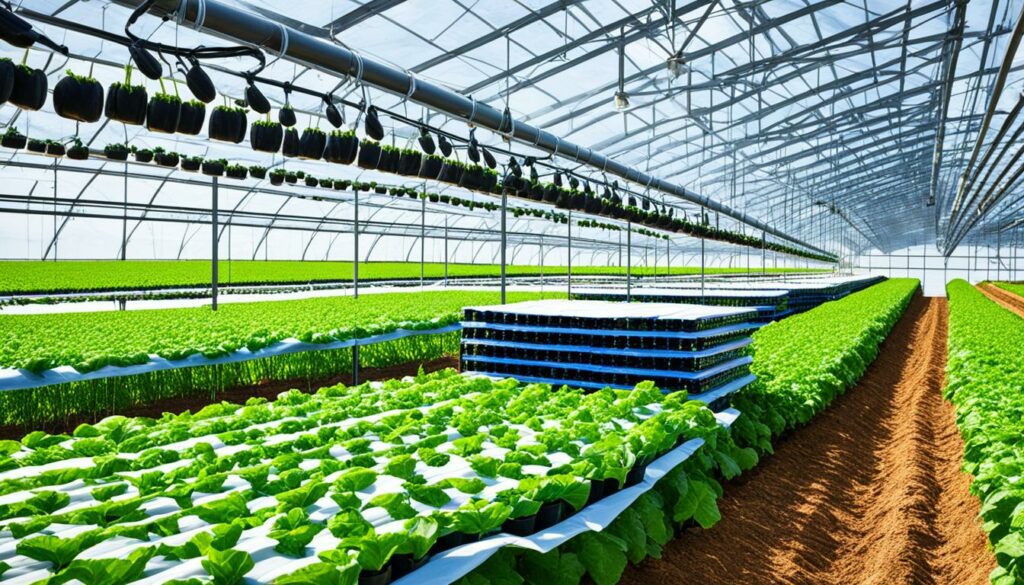
AI, for instance, makes it easier to know what to sell and how to sell it. This leads to selling more. More people are buying things on their phones. So, phone-friendly websites are a must for farmers.
People want to buy things easily and quickly. Shops that sell in many ways catch more buyers. Using fun apps is key to getting people to look and buy.
Looking up local shops online is very popular now. This means farmers should have a good website. People want to buy local more than ever.
Unified Commerce is the future trend for agricultural sales. Integrating physical and digital channels creates a seamless customer experience, increasing touchpoints and enhancing customer loyalty.
New ways of selling, like in stores by the brands themselves, are very important. They help make more money and stay in the game for a long time.
| Factor | Impact |
|---|---|
| Mobile Optimisation | 40.4% of eCommerce sales via mobile; necessity for mobile-friendly platforms. |
| Social Media Engagement | Critical for reaching younger, tech-savvy consumers. |
| Data Analytics | Enhances targeted marketing and inventory management. |
| Local Online Presence | 900% increase in searches; vital for connecting with local consumers. |
To sum up, being up-to-date with farm tech and knowing what people want is crucial. This lets farms use many ways to sell and grow well over time.
In today’s agriculture market, it’s key to use strong multi-channel sales methods. This means selling in physical shops, online, and on social media. Such an approach helps farms reach more people and makes shopping better for customers.
By selling in many places, farms can learn a lot about what customers like. This helps them do better advertising and stock their products right. It also lets them give customers what they want, which keeps them coming back. Selling in different ways also makes sure the farm’s message is clear. This leads to better service and a good reputation.
When farms sell both online and offline using things like WooCommerce, they can appeal to a bigger market. This increases their sales. Shops at local markets or direct selling offer a chance for customers to touch and feel products. But, online sales make buying easy and quick.
Using various channels needs a plan. It should make buying smooth for customers. By using tech and automated systems, mistakes are fewer and orders are faster. Knowing where your order is shows you care about your customers. This way, farms can grow and change with the market, staying successful for a long time.
Multi-channel sales mean selling farm products in many ways. This could be online, in shops, at markets, or directly to customers. It helps farms reach more people and make more money.
Using many sales methods makes more people know about the farm. It can also increase profit and meet different customer needs. But it’s hard to manage all the sales and keep the brand the same everywhere.
Good places to sell are online sites like Amazon, eBay, and Food Farm Hub. Also, use your own website, social media, and shops you can visit.
It lets farms look at costs for things like handling after harvest, travel, ads, and selling fees. By understanding these costs, they can find the best marketing ways to make more money.
They should look at prices, how much time it needs, what customers want, and if there will be unsold products. This way, farms can see which sales methods work best together to make more money.
Farms can see how using many sales ways can change their business and make more money. They can also learn what works well and what mistakes to avoid.
Use tools like Local Food Marketplace to connect sales ways better. This helps keep track of what you have to sell, and customers feel like they’re buying from one place.
E-commerce means farms sell online. This can help them reach more customers and keep their brand the same, leading to better sales and more people knowing about the farm.
Use Facebook, Twitter, and Instagram to talk to customers and show your products. Posts, videos, and talking to people can all help sell more and make customers happy.
It’s good to keep track of what you have to sell, talk to customers a lot, and follow the marketplace’s rules. This can make you more visible and sell more.
Selling straight to customers cuts out the middleman. This way, farms can set their own prices, talk directly to customers, and make their brand better known.
Good customer service, making each interaction personal, and helping the same way on every channel can keep customers happy and coming back.
Looking at sales numbers and trends tells a lot about what customers like and how to manage what you have to sell. This info helps make smarter choices in how you sell and market your products, which can lead to more profit.
Using all doable ways to market your farm, keeping your brand the same and your message clear, can help you stand out to customers.
Farms should look at new technology and what customers are starting to like. This info can help them sell and market better, making more money.